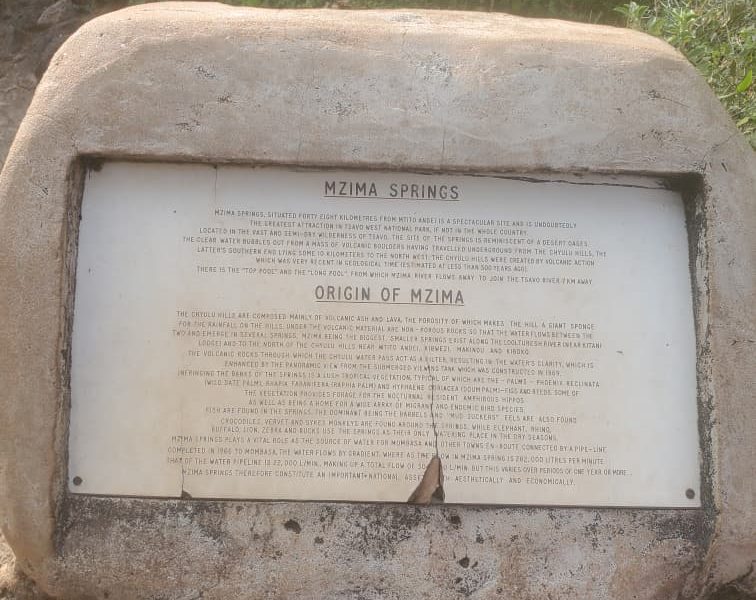Mzima Springs in in Tsavo West National Park
Tucked away in the heart of Tsavo West National Park lies a remarkable natural wonder known as Mzima Springs. This oasis, fed by underground aquifers from the Chyulu Hills, is a vital water source that sustains a diverse array of wildlife and vegetation in an otherwise arid landscape. Mzima Springs provides a unique contrast to the surrounding savanna, drawing both animals and visitors to its refreshing waters. In this article, we will delve into the history, ecology, and significance of Mzima Springs, exploring why it is one of the most enchanting destinations in Tsavo.

Historical Background of Mzima Springs in Tsavo West National Park
Discovery and Development
Mzima Springs was first discovered in the early 20th century, when it became an important water source for local wildlife and communities. The springs were officially recognized as a protected area in 1948 when Tsavo National Park was established. Over the years, Mzima Springs has played a crucial role in the conservation of the region’s biodiversity and has become an essential stop for tourists exploring Tsavo West.
Cultural Significance
For local communities, Mzima Springs has been more than just a water source. The area is steeped in cultural significance, often associated with traditional beliefs and practices. Local folklore speaks of spirits that inhabit the springs, and the site has historically been a place for rituals and gatherings. This cultural dimension adds depth to the natural beauty of Mzima Springs, making it a site of both ecological and spiritual importance.
The Ecology of Mzima Springs
Water Source and Biodiversity
Mzima Springs emerges from the ground in several pools and channels, creating a lush environment that supports a wide variety of flora and fauna. The springs are fed by rainwater that seeps through the porous volcanic rock of the Chyulu Hills, making it one of the few permanent water sources in the region. This continuous flow of fresh water nurtures a vibrant ecosystem, creating a haven for wildlife.
The lush vegetation around Mzima Springs includes palms, acacias, and various grasses. This greenery provides essential habitat for many animal species, including elephants, hippos, crocodiles, and numerous bird species. The springs are particularly famous for their large population of hippos, which can often be seen basking in the shallow waters or lurking just beneath the surface.
Wildlife Spotting
Visitors to Mzima Springs can enjoy excellent wildlife viewing opportunities. The area is known for its diverse birdlife, including kingfishers, fish eagles, and various migratory species. Birdwatchers often flock to Mzima Springs to capture glimpses of these feathered residents, especially during the wet season when migratory birds are present.
In addition to birds, the springs attract various mammals. Elephants, in particular, are frequent visitors, drawn by the promise of water. Their presence can be both awe-inspiring and humbling, as they interact with the springs and the surrounding landscape. Crocodiles are also a common sight, often sunbathing on the banks or lurking stealthily in the water, highlighting the rich biodiversity supported by this oasis.
Activities at Mzima Springs
Nature Walks and Guided Tours
One of the best ways to experience Mzima Springs is through guided nature walks. Local guides offer insights into the flora and fauna, sharing knowledge about the ecosystem and the cultural significance of the area. These walks provide visitors with a more intimate understanding of the environment, allowing them to appreciate the intricate relationships between species and their habitats.
The trails around Mzima Springs are well-maintained, making them accessible to visitors of all ages. Strolling along the pathways, one can enjoy the sights and sounds of the springs while absorbing the stunning scenery. The juxtaposition of the lush greenery against the arid landscape creates a picturesque setting that is perfect for photography and exploration.
Hippo Viewing and Underwater Observatory
One of the unique features of Mzima Springs is the underwater observatory, which allows visitors to view hippos and other aquatic life up close. This experience is particularly popular among families and wildlife enthusiasts. The observatory offers a fascinating glimpse into the underwater world, showcasing the behavior of hippos, fish, and other species that inhabit the springs.

Hippo viewing is best done early in the morning or late in the afternoon when the animals are most active. From the banks of the springs, visitors can watch these magnificent creatures as they emerge from the water, interact with one another, and occasionally display their playful nature.
Importance of Water Conservation
The preservation of Mzima Springs is crucial not only for the local wildlife but also for the surrounding communities. As a vital water source, it plays a significant role in sustaining the biodiversity of Tsavo West National Park. Conservation efforts focus on protecting the water quality and ensuring that the springs remain a healthy habitat for the myriad species that rely on them.
Community Involvement
Local communities are integral to the conservation of Mzima Springs. Through education and awareness programs, residents are encouraged to participate in sustainable practices that protect the springs and their surroundings. Initiatives such as eco-tourism provide economic benefits while fostering a sense of stewardship for the environment.
Collaborations between conservation organizations, local governments, and communities are essential for the ongoing protection of Mzima Springs. By involving the local population in conservation efforts, the long-term sustainability of this precious resource can be ensured.
What is the best time to visit Mzima Springs in Tsavo?
The best time to visit Mzima Springs is during the dry season, which typically runs from June to October. During this period, wildlife congregates around the springs, making for excellent viewing opportunities. The weather is generally pleasant, with clear skies and cooler temperatures, perfect for outdoor activities.
Access and Accommodation
Mzima Springs is easily accessible by road from major entry points into Tsavo West National Park. Visitors can stay at nearby lodges or campsites, offering a range of accommodations to suit different budgets. Staying close to the springs allows for early morning or late afternoon excursions, maximizing wildlife viewing opportunities.
Guided Tours
To enhance the experience, it is advisable to join guided tours led by knowledgeable local guides. These tours not only provide valuable insights into the ecology and cultural significance of Mzima Springs but also ensure that visitors can navigate the area safely and responsibly.
Visit Mzima Springs now and create everlasting memories
Mzima Springs is a treasure within Tsavo West National Park. They serve as a vital water source and a sanctuary for diverse wildlife. Its lush vegetation, vibrant ecosystems, and unique geological features make it a must-visit destination. The cultural significance and ongoing conservation efforts surrounding Mzima Springs highlight the importance of protecting this natural wonder for future generations.
Whether you are an avid wildlife enthusiast, a nature lover, or simply seeking a tranquil escape, Mzima Springs offers a captivating experience that will leave you with lasting memories. As you stand by the crystal-clear waters, surrounded by the sounds of nature, you will come to appreciate the beauty and importance of this hidden oasis in the heart of Tsavo West National Park.















